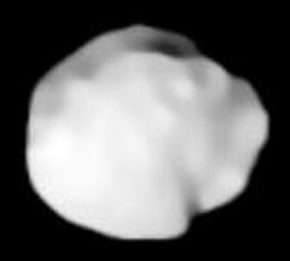
Back 3 Juno Afrikaans (3) Juno ALS 3 جونو Arabic 3 جونو (كويكب) ARZ 3 Juno AST 3 Yunona Azerbaijani (3) Юнона Byelorussian Юнона (астэроід) BE-X-OLD 3 Юнона Bulgarian (3) Juno Breton
 | |
| Discovery | |
|---|---|
| Discovered by | Karl Ludwig Harding |
| Discovery date | 1 September 1804 |
| Designations | |
| (3) Juno | |
| Pronunciation | /ˈdʒuːnoʊ/ JOO-noh[1] |
Named after | Juno (Latin: Iūno) |
| Main belt (Juno clump) | |
| Adjectives | Junonian /dʒuːˈnoʊniən/[2] |
| Symbol | |
| Orbital characteristics[3] | |
| Epoch 13 September 2023 (JD 2453300.5) | |
| Aphelion | 3.35 AU (501 million km) |
| Perihelion | 1.985 AU (297.0 million km) |
| 2.67 AU (399 million km) | |
| Eccentricity | 0.2562 |
| 4.361 yr | |
Average orbital speed | 17.93 km/s |
| 37.02° | |
| Inclination | 12.991° |
| 169.84° | |
| 2 April 2023 | |
| 247.74° | |
| Earth MOID | 1.04 AU (156 million km) |
| Proper orbital elements[4] | |
Proper semi-major axis | 2.6693661 AU |
Proper eccentricity | 0.2335060 |
Proper inclination | 13.2515192° |
Proper mean motion | 82.528181 deg / yr |
Proper orbital period | 4.36215 yr (1593.274 d) |
Precession of perihelion | 43.635655 arcsec / yr |
Precession of the ascending node | −61.222138 arcsec / yr |
| Physical characteristics | |
| Dimensions | (288 × 250 × 225) ± 5 km[5] (320 × 267 × 200) ± 6 km[6] |
| 254±2 km[5] 246.596±10.594 km[3] | |
| Mass | (2.7±0.24)×1019 kg[5] (2.86±0.46)×1019 kg[7][a] |
Mean density | 3.15±0.28 g/cm3[5] 3.20±0.56 g/cm3[7] |
Equatorial surface gravity | 0.112 m/s2 (0.0114 g0) |
Equatorial escape velocity | 0.168 km/s |
| 7.21 hr[3] (0.3004 d)[8] | |
Equatorial rotation velocity | 31.75 m/s[b] |
Pole ecliptic latitude | 27° ± 5°[9] |
Pole ecliptic longitude | 103° ± 5°[9] |
| 0.202[5] 0.238[3][10] | |
| Temperature | ~163 K max: 301 K (+28°C)[11] |
| S[3][12] | |
| 7.4[13][14] to 11.55 | |
| 5.33[3][10] | |
| 0.30" to 0.07" | |
Juno (minor-planet designation: 3 Juno) is a large asteroid in the asteroid belt. Juno was the third asteroid discovered, in 1804, by German astronomer Karl Harding.[15] It is tied with three other asteroids as the thirteenth largest asteroid, and it is one of the two largest stony (S-type) asteroids, along with 15 Eunomia. (Ceres is the largest asteroid.) It is estimated to contain 1% of the total mass of the asteroid belt.[16]
- ^ "Juno". Dictionary.com Unabridged (Online). n.d.
- ^ "Junonian". Oxford English Dictionary (Online ed.). Oxford University Press. (Subscription or participating institution membership required.)
- ^ a b c d e f Cite error: The named reference
jpldatawas invoked but never defined (see the help page). - ^ "AstDyS-2 Juno Synthetic Proper Orbital Elements". Department of Mathematics, University of Pisa, Italy. Archived from the original on 9 July 2021. Retrieved 1 October 2011.
- ^ a b c d e P. Vernazza et al. (2021) VLT/SPHERE imaging survey of the largest main-belt asteroids: Final results and synthesis. Astronomy & Astrophysics 54, A56
- ^ Baer, Jim (2008). "Recent Asteroid Mass Determinations". Personal Website. Archived from the original on 2 July 2013. Retrieved 3 December 2008.
- ^ a b James Baer, Steven Chesley & Robert Matson (2011) "Astrometric masses of 26 asteroids and observations on asteroid porosity." The Astronomical Journal, Volume 141, Number 5
- ^ Harris, A. W.; Warner, B. D.; Pravec, P., eds. (2006). "Asteroid Lightcurve Derived Data. EAR-A-5-DDR-DERIVED-LIGHTCURVE-V8.0". NASA Planetary Data System. Archived from the original on 9 April 2009. Retrieved 15 March 2007.
- ^ a b Cite error: The named reference
kaasalainen2002was invoked but never defined (see the help page). - ^ a b Davis, D. R.; Neese, C., eds. (2002). "Asteroid Albedos. EAR-A-5-DDR-ALBEDOS-V1.1". NASA Planetary Data System. Archived from the original on 17 December 2009. Retrieved 18 February 2007.
- ^ Lim, Lucy F.; McConnochie, Timothy H.; Bell, James F.; Hayward, Thomas L. (2005). "Thermal infrared (8–13 μm) spectra of 29 asteroids: the Cornell Mid-Infrared Asteroid Spectroscopy (MIDAS) Survey". Icarus. 173 (2): 385–408. Bibcode:2005Icar..173..385L. doi:10.1016/j.icarus.2004.08.005.
- ^ Neese, C., ed. (2005). "Asteroid Taxonomy.EAR-A-5-DDR-TAXONOMY-V5.0". NASA Planetary Data System. Archived from the original on 5 September 2006. Retrieved 24 December 2013.
- ^ "AstDys (3) Juno Ephemerides". Department of Mathematics, University of Pisa, Italy. Archived from the original on 9 July 2021. Retrieved 26 June 2010.
- ^ "Bright Minor Planets 2005". Minor Planet Center. Archived from the original on 29 September 2008.
- ^ Cunningham, Clifford J (2017), Bode's Law and the discovery of Juno : historical studies in asteroid research, Springer, ISBN 978-3-319-32875-1
- ^ Pitjeva, E. V. (2005). "High-Precision Ephemerides of Planets—EPM and Determination of Some Astronomical Constants" (PDF). Solar System Research. 39 (3): 176. Bibcode:2005SoSyR..39..176P. doi:10.1007/s11208-005-0033-2. S2CID 120467483. Archived from the original (PDF) on 31 October 2008.
Cite error: There are <ref group=lower-alpha> tags or {{efn}} templates on this page, but the references will not show without a {{reflist|group=lower-alpha}} template or {{notelist}} template (see the help page).